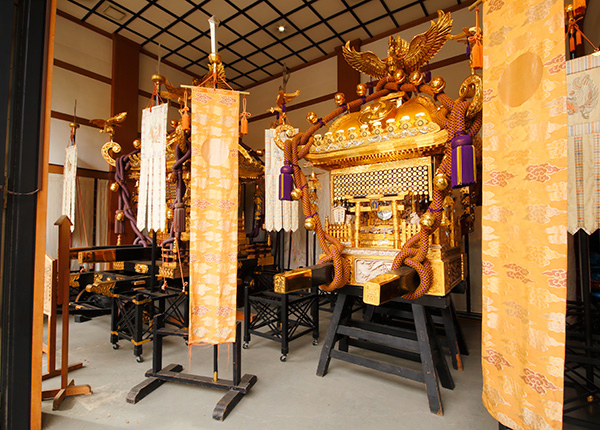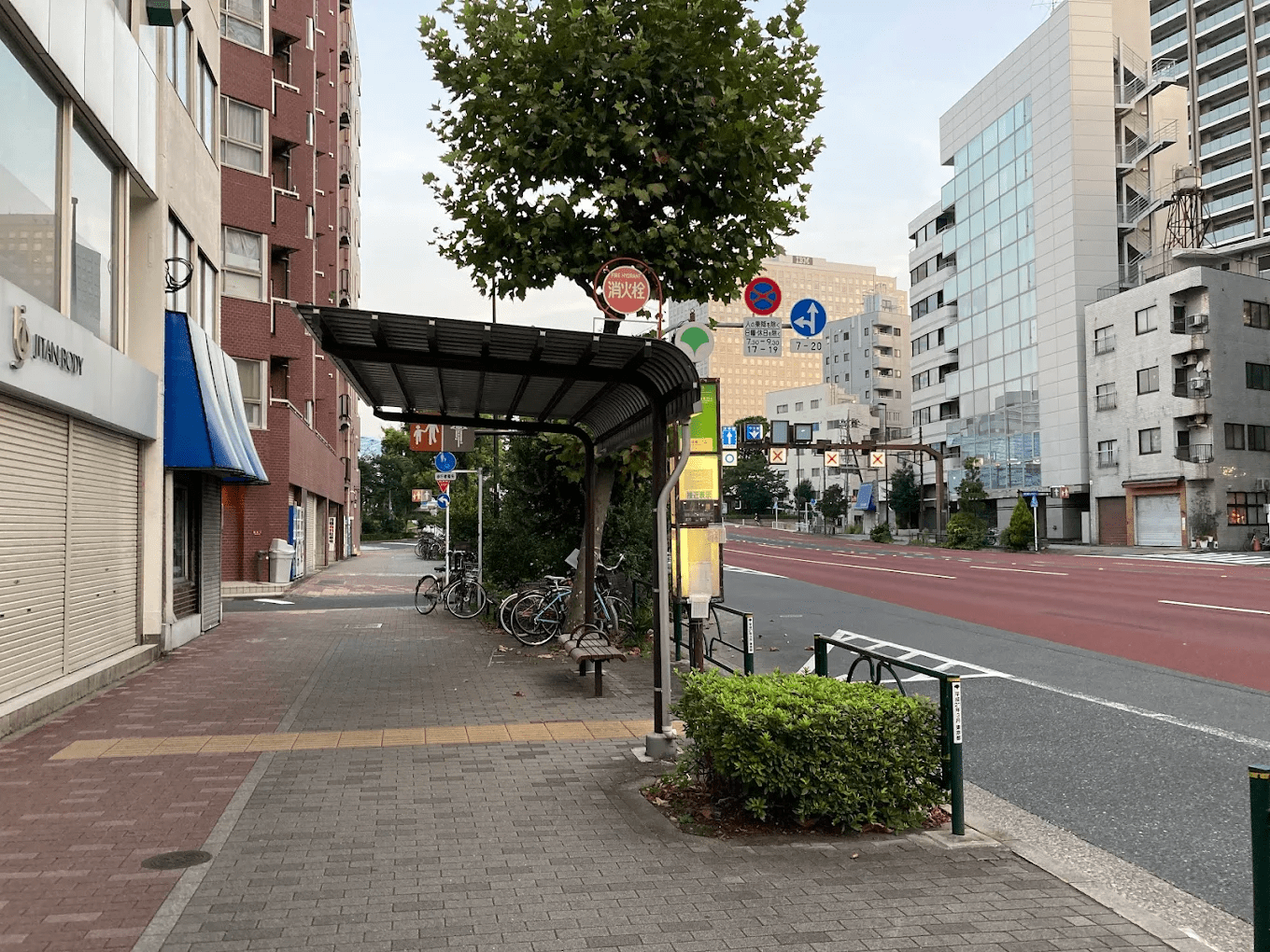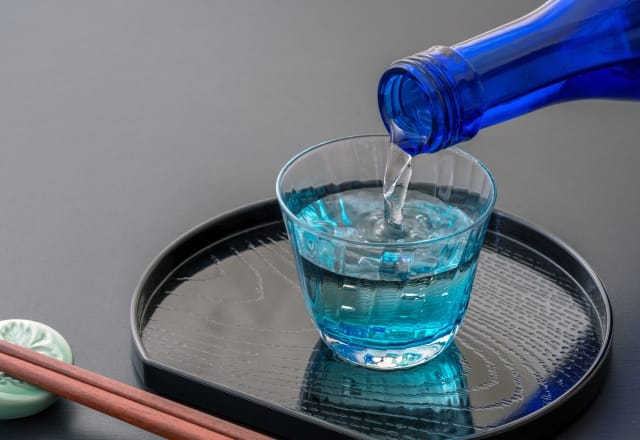Fukagawa Matsuri 2026: Local's Guide to Tokyo's Water-Splashing Festival | Best Spots & How to Join
Fukagawa Matsuri is a traditional event that symbolizes Tokyo's summer.
Centered around Tomioka Hachimangu, this festival is also called "Mizukake Festival (Water-Splashing Festival)" due to the sight of large amounts of water being splashed around.
Both mikoshi bearers and spectators come together in excitement, filled with energy that blows away the midsummer heat.
In this article, as a writer who loves festivals, I will introduce in detail the history, characteristics, and highlights of Fukagawa Matsuri.
Let's experience Tokyo's most vibrant traditional event.
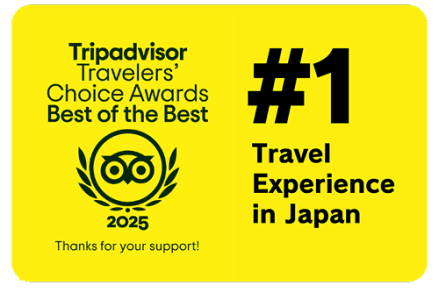
Traditional Festivals are Held at Shrines and Temples Throughout Tokyo
In Tokyo, festivals that have inherited the culture of the Edo period (1603–1868) are still held at shrines and temples throughout the area.
The spirit that "Edokko (locals born and raised in Edo, today's Tokyo) love festivals" remains unchanged from past to present.
Festivals are important occasions where people in the community work together to carry mikoshi and deepen their regional bonds.
This passionate culture has been passed down through generations to modern-day Tokyo, and traditional festivals are carefully preserved.
Fukagawa Matsuri is a Historic Festival Counted Among the Three Major Festivals of Edo
The Fukagawa Matsuri introduced here is the annual festival of Tomioka Hachimangu, which has continued since 1627.
The biggest characteristic is that spectators along the roadside splash water on the mikoshi bearers. The act of splashing water has the meaning of purifying the mikoshi bearers and the mikoshi.
Fukagawa Matsuri is counted as one of Tokyo's representative "The Three Major Festivals of Edo," and among them, it is still loved by many people as the most vigorous and lively summer festival.
<Information>
- Date: August 15
- Access: 3-minute walk from Tokyo Metro Tozai Line "Monzen-Nakacho Station"
6-minute walk from Toei Subway Oedo Line "Monzen-Nakacho Station"
15-minute walk from JR Keiyo Line "Etchujima Station"
- Admission Fee: Free
- Website: http://www.tomiokahachimangu.or.jp/annai/maturi/maturih1.html
What are The Three Major Festivals of Edo?

The Three Major Festivals of Edo refer to the three most important and large-scale festivals in Tokyo.
The three festivals are as follows:
- Kanda Matsuri: Held in May at Kanda Myojin Shrine
- Sanno Matsuri: Held in June at Hie Shrine
- Fukagawa Matsuri: Held in August at Tomioka Hachimangu
Each festival has a designated year for its large-scale Main Festival, with Kanda Matsuri held grandly in odd-numbered years, Sanno Matsuri in even-numbered years, and Fukagawa Matsuri once every three years.
What is Tomioka Hachimangu, Where Fukagawa Matsuri Takes Place?
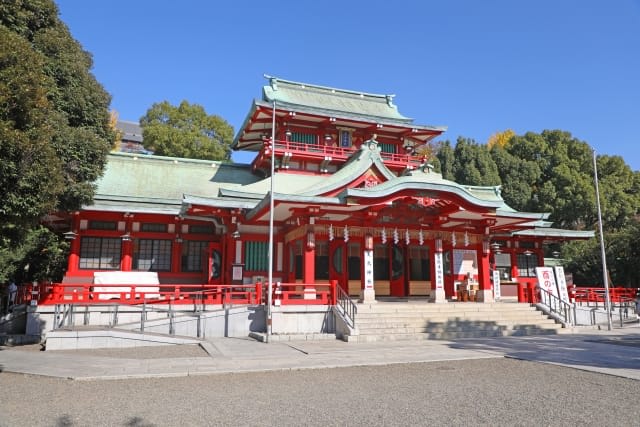
Tomioka Hachimangu, the venue for Fukagawa Matsuri, was founded in 1627.
Located in Tokyo's Fukagawa area, it has been an important base of faith cherished by people who have lived in this region since ancient times.
People have prayed for business prosperity and family safety, treasuring this shrine as a spiritual support.
Furthermore, this shrine is also famous as the place where Sumo, Japan's national sport, began.
Therefore, a large monument inscribed with the names of successive highest-ranking champions (Yokozuna) stands within the shrine grounds.
- Address: 1-20-3 Tomioka, Koto-ku, Tokyo
- Business Hours: 24 hours
- Closed: None
- Phone Number: 03-3642-1315
- Official Website: http://www.tomiokahachimangu.or.jp/
Easy-to-Understand Explanation of the Fukagawa Festival System and Three Formats
Fukagawa Festival is held annually, but its content changes in rotation on a three-year cycle.
Since the scale and content of the festival differ completely depending on the year, it is important to understand this festival cycle.
-Hon-matsuri (Main Festival): The grandest festival held once every three years
-Gohonsha-matsuri (Main Shrine Festival): Festival held in the year following Hon-matsuri
-Kage-matsuri (Shadow Festival): Festival held in the year before Hon-matsuri
Let me explain each festival in detail.
Hon-matsuri
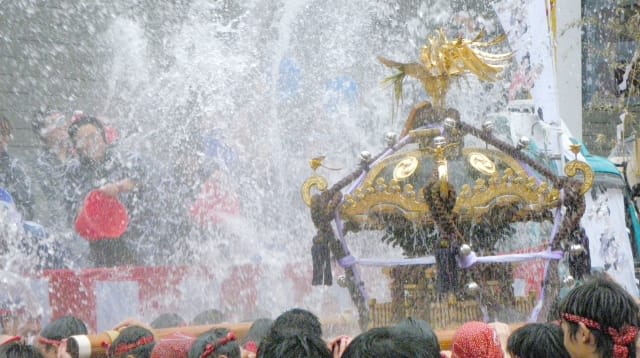
Hon-matsuri (Main Festival) is the highlight of Fukagawa Matsuri, held once every three years.
The mikoshi from Tomioka Hachimangu and more than 50 mikoshi owned by neighborhood associations gather together and parade through an approximately 8km course from morning to evening.
The biggest characteristic is that spectators along the roadside splash water on the mikoshi bearers and mikoshi.
Not only buckets and water guns, but there are also places where local fire brigades spray large amounts of water with fire hoses, and the entire town is enveloped in water spray and excitement.
Being overwhelmed by the tremendous energy of the mikoshi bearers and becoming soaking wet together with the spectators is the most exciting experience that can only be tasted at Hon-matsuri.
The 2026 Fukagawa Matsuri will be the Especially Exciting "Hon-matsuri"
2026 is the most important year when that once-every-three-years Hon-matsuri will be held.
The "Mikoshi Rengō Togyo" where more than 50 mikoshi gather all at once, and the Water-Splashing that floods the entire town, can only be experienced in this Hon-matsuri year.
If you want to experience the true passion, excitement, and community unity that Japanese festivals possess, 2026 is the perfect timing to visit Fukagawa Matsuri.
Gohonsha-matsuri
Source:Wikipedia
Gohonsha-matsuri (Main Shrine Festival) is a festival held in the year following Hon-matsuri. In this festival, there is only one mikoshi.
After Shinto priests perform a sacred ritual to transfer the divine spirit to the mikoshi in the early morning, the mikoshi is carried by local representatives and tours seven districts over the course of a day.
And in this festival as well, Fukagawa's famous Water-Splashing takes place.
Although the scale is smaller than Hon-matsuri, the sight of the golden-colored mikoshi bathed in summer light and water spray is magnificent.
One of the charms of Gohonsha-matsuri is that you can enjoy not only the power but also the solemn Shinto rituals together.
Kage Matsuri
Source:Wikipedia
Kage-matsuri (Shadow Festival) is held in the year before Hon-matsuri.
In this festival, flashy Water-Splashing and large-scale mikoshi processions are not conducted.
The highlight of this festival is the small mikoshi carried by local children. They march with the mikoshi while calling out energetically.
Along the roadside, local people send encouragement with smiles, and the entire town is enveloped in a very warm atmosphere.
When I saw that sight, I felt, "This is how children become familiar with this festival and inherit the tradition."
This is the ideal festival for those who want to experience the warm atmosphere of a community trying to pass on tradition to the next generation.
Locals Teach You! Must-See Events and Ways to Enjoy Fukagawa Matsuri
Capture the Magnificent "Ichinomiya Mikoshi" in Photos
Source:Koto City
What you absolutely must capture in photos at Fukagawa Matsuri is the "Ichinomiya Mikoshi (First Main Shrine Mikoshi)," which is the symbol of the festival.
This is truly one of Japan's largest mikoshi, befitting the description of magnificent and gorgeous, boasting a height of approximately 4.4 meters and a weight of approximately 4.5 tons.
The roof is adorned with 24kg of pure gold, the phoenix's chest features a 7-carat diamond, and it is also lavishly decorated with platinum and rubies.
Due to its enormous size and weight, it is not carried. However, it is specially displayed during the festival period.
When I first saw it up close, I was breathless at its dazzling golden brilliance, the exquisiteness of its craftsmanship, and its luxurious appearance studded with jewels.
Please take time to fully appreciate the magnificence of the Ichinomiya Mikoshi within the shrine grounds.
Experience the Mikoshi Parading Through the Streets and the Intense Heat of the Bearers That Makes the Ground Rumble
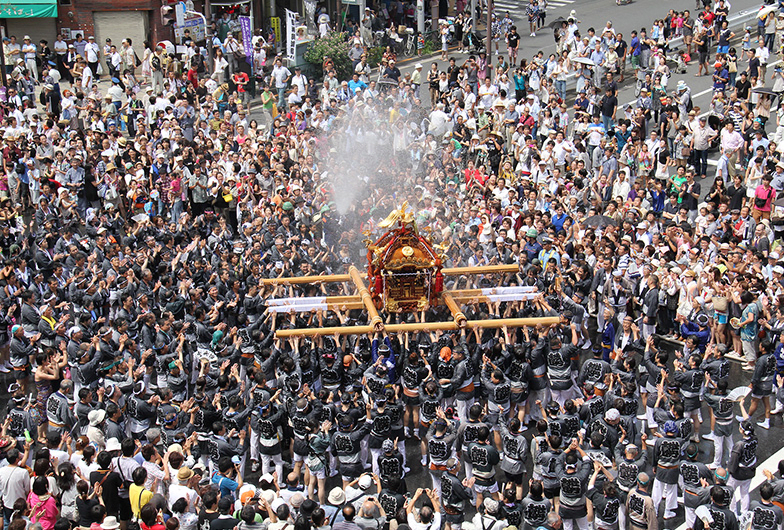
Source:Koto City
During the Hon-matsuri of Fukagawa Matsuri, as many as 53 mikoshi parade through the town all at once.
From morning onwards, the sound of drums echoing, the calls of the mikoshi bearers, and the cheers of spectators overlap, creating an intensity that makes the entire city seem to shake.
Each time a mikoshi approaches, the ground trembles, and you can feel deep bass sounds resonating to your very core.
The mikoshi bearers grit their teeth, raise their voices, and support the mikoshi with all their bodily strength. Their expressions are the picture of seriousness.
In the sight of them advancing while being drenched in water splashes, you can feel the pride and determination of the people living in Fukagawa.
When I stood there myself, even though I was just watching, my heart grew warm.
Please experience this powerful atmosphere up close to the mikoshi.
Participation is Possible! Join in the Dynamic Water-Splashing or Capture the Scene in Photos
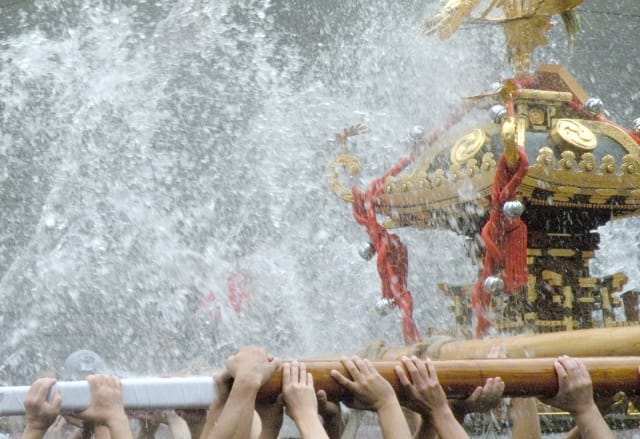
The Water-Splashing that has become a specialty of Fukagawa Matsuri is not merely a performance, but has the meaning of purifying the mikoshi and mikoshi bearers and praying for their safety.
Furthermore, it also serves the role of cooling down the mikoshi bearers who are working hard under the scorching midsummer sun, acting as a heat stroke prevention measure.
Along the roadside, spectators can also freely splash water from buckets and hoses.
The sight of steam rising from the bodies of the mikoshi bearers amid the mixture of water splashes and intense heat is truly spectacular.
The water pressure is strong and spectators also get completely soaked, so if you want to take photos, waterproof covers or waterproof cases for smartphones are essential.
Please take on the challenge with the resolve to get wet, and experience the realism of this festival with your whole body.
Saga 1-chome Intersection is the Recommended Spot for Water-Splashing
Source:Google Maps
"Saga 1-chome Intersection" is a location that is highly popular among locals as a highlight point for Water-Splashing at Fukagawa Matsuri.
Every time a mikoshi reaches this intersection, water released vigorously from the bed of a truck dances through the air.
I also watched from this location before, and spectators got caught up in it and became completely soaked.
Please enjoy this festival as one with the people around you.
Enjoy the Festival Food from Stalls During the Festival Period
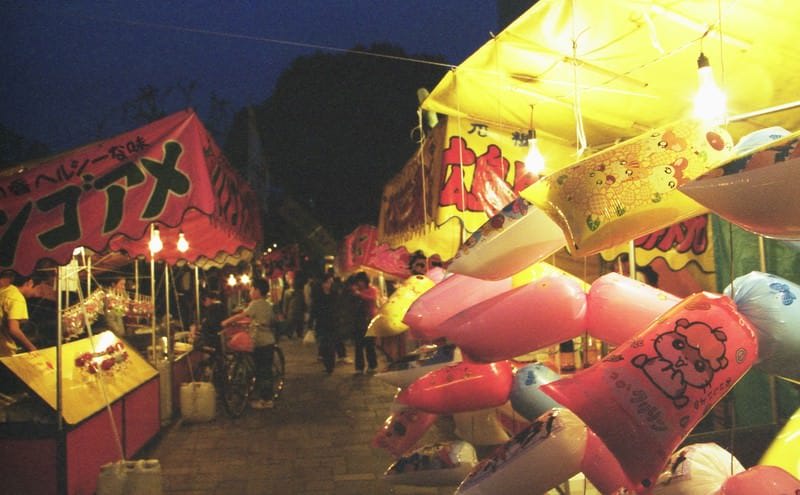
Another enjoyment of the Fukagawa Matsuri is the street food stalls lined up throughout the town.
At Tomioka Hachimangu, stalls wrapped in savory aromas are lined up in rows.
Classic foods that symbolize Japanese summer festivals are available, including stir-fried noodles, octopus balls, grilled squid, and shaved ice.
If you want to try local flavors, Fukagawa-meshi (clam rice) and Monjayaki (savory pancake) are also recommended.
In the evening, the lights of the stalls and people's laughter overlap, creating a warm atmosphere unique to the downtown area.
Through food, experience Japanese festival culture with all five senses.
For Those Interested in Japanese Tradition and Culture, Explore the Historic Town with a Local Guide
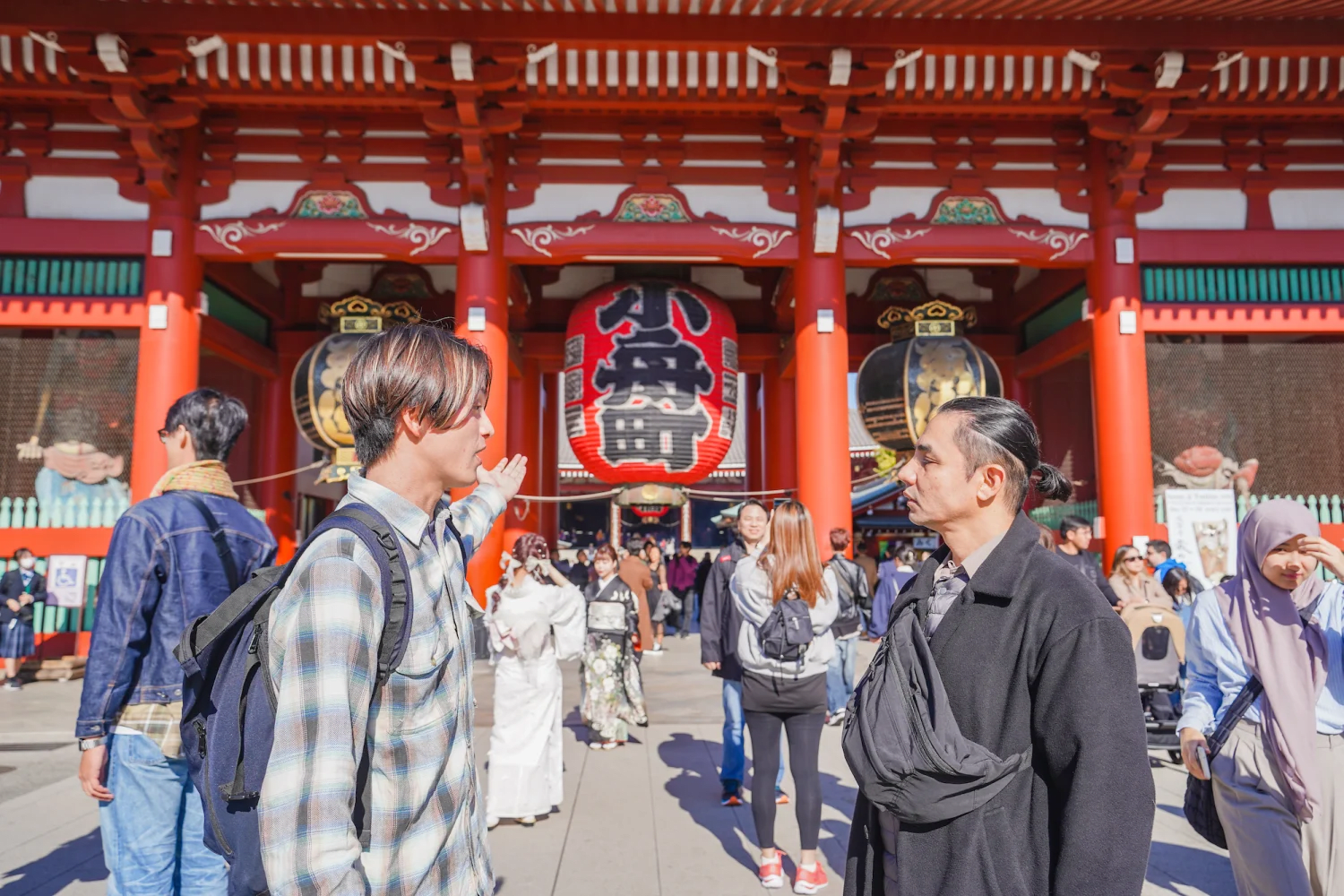
The "Asakusa Cultural Walk & Matcha Making Tour" is a luxurious walking tour where you can experience Japanese traditional culture in 3 hours, set in Asakusa.
While touring famous spots such as Sensō-ji Temple and Nakamise Street with a local guide, you'll learn about Buddhism, Japanese faith, and traditional ways of life.
In a quiet tea room, you'll whisk Matcha with your own hands and experience a peaceful Japanese moment. Additionally, you can try making Monjayaki (savory pancake), which originated in Asakusa.
This is perfect for those who want to experience Japanese culture rather than just sightseeing, and for those interested in history, food, and tradition.
With careful explanations from a local guide, this is a tour where you can deeply feel the charm of Asakusa that guidebooks cannot offer.
- Meeting Point: In front of the police box at Sensō-ji Temple's Kaminarimon Gate
- Tour Area: Around Asakusa
- Start Time: 11:00
Recommended Traditional August Events for Those Who Want to Experience Japanese Festivals
Tsukiji Honganji Bon Dance Festival
Source:PR TIMES
If you want to casually experience Japanese summer traditions in Tokyo, the "Tsukiji Honganji Bon Dance Festival" held at Tsukiji Honganji is recommended.
People in Yukata gather in the temple grounds and dance around a large tower platform to the rhythm of drums. Even beginners can join the circle, so please try participating.
Between the Bon dances, you can enjoy Tsukiji Honganji in unique ways, such as worshipping at the illuminated main hall or toasting at the special beer garden.
One of the enjoyments is that many famous gourmet shops from Tsukiji gather in the temple grounds.
<Information>
- Dates: 4 days from late July to early August
- Access: Directly connected to Exit 1 of "Tsukiji Station" on the Tokyo Metro Hibiya Line
5-minute walk from Exit 4 of "Shintomicho Station" on the Tokyo Metro Yurakucho Line
5-minute walk from Exit 5 of "Higashi-Ginza Station" on the Toei Subway Asakusa Line
5-minute walk from Exit A1 of "Tsukiji-shijo Station" on the Toei Subway Oedo Line
- Admission: Free
- Website: https://tsukijihongwanji.jp/news/10279/ (Reference: 2025)
Meiji Jingu Gaien Fireworks Festival
Source:PR TIMES
The "Meiji Jingu Gaien Fireworks Festival," which colors Tokyo's summer nights, is a special event where you can experience the skill and beauty of Japanese fireworks artisans.
Approximately 10,000 fireworks fill the night sky. The art of light, meticulously calculated in color, shape, and timing, is worth seeing.
The collaboration with live music is also a highlight, allowing you to enjoy a fantastic time where sound and light harmonize perfectly.
Reserved seating areas are available at multiple venues, including Meiji Jingu Stadium, where you can leisurely enjoy the beauty of the fireworks.
This is a fireworks festival you should definitely visit, where you can feel Japanese beauty in the heart of the city.
<Information>
- Dates: Mid-August annually
- Access:
[Jingu Stadium]
JR Sobu Line "Sendagaya Station" "Shinanomachi Station"
Toei Oedo Line "Kokuritsu-Kyogijo Station"
[Chichibunomiya Rugby Stadium]
Tokyo Metro / Toei Oedo Line "Aoyama-itchome Station"
- Admission:
[Jingu Stadium (All Reserved Seats)]
・Arena SS Seat ¥14,000
・Arena S Seat ¥11,000
・Arena A Seat ¥10,000
・Stand S Seat ¥11,000
・Stand A Seat ¥10,000
[Chichibunomiya Rugby Stadium (All Reserved Seats)]
・Stand Seat ¥7,000
- Website: https://www.jinguhanabi.com/ (Reference: 2025)
Harajuku Omotesando Genki Matsuri Super Yosakoi
Source:Official website
Yosakoi is a dance style born in Kochi Prefecture, Japan. It is characterized by dancing while sounding Naruko, a small wooden percussion instrument.
At the Harajuku Omotesando Genki Matsuri Super Yosakoi, over 100 teams from across the country gather.
Each team freely arranges their music, costumes, and choreography, and parades while dancing magnificently on the Omotesando Avenue of Meiji Jingu Shrine.
This festival, where tradition and modern energy merge, is a summer tradition that energizes you just by watching.
<Information>
- Dates: Saturday and Sunday in late August
- Access: 1-minute walk from the west exit of the Omotesando exit of JR "Harajuku Station"
1-minute walk from Exit 2 of "Meiji-Jingumae Station" on the Tokyo Metro Chiyoda Line and Fukutoshin Line
1-minute walk from Exit A1/A2 of "Omotesando Station" on the Tokyo Metro
- Admission: Free
- Website: https://www.super-yosakoi.tokyo/ (Reference: 2025)



